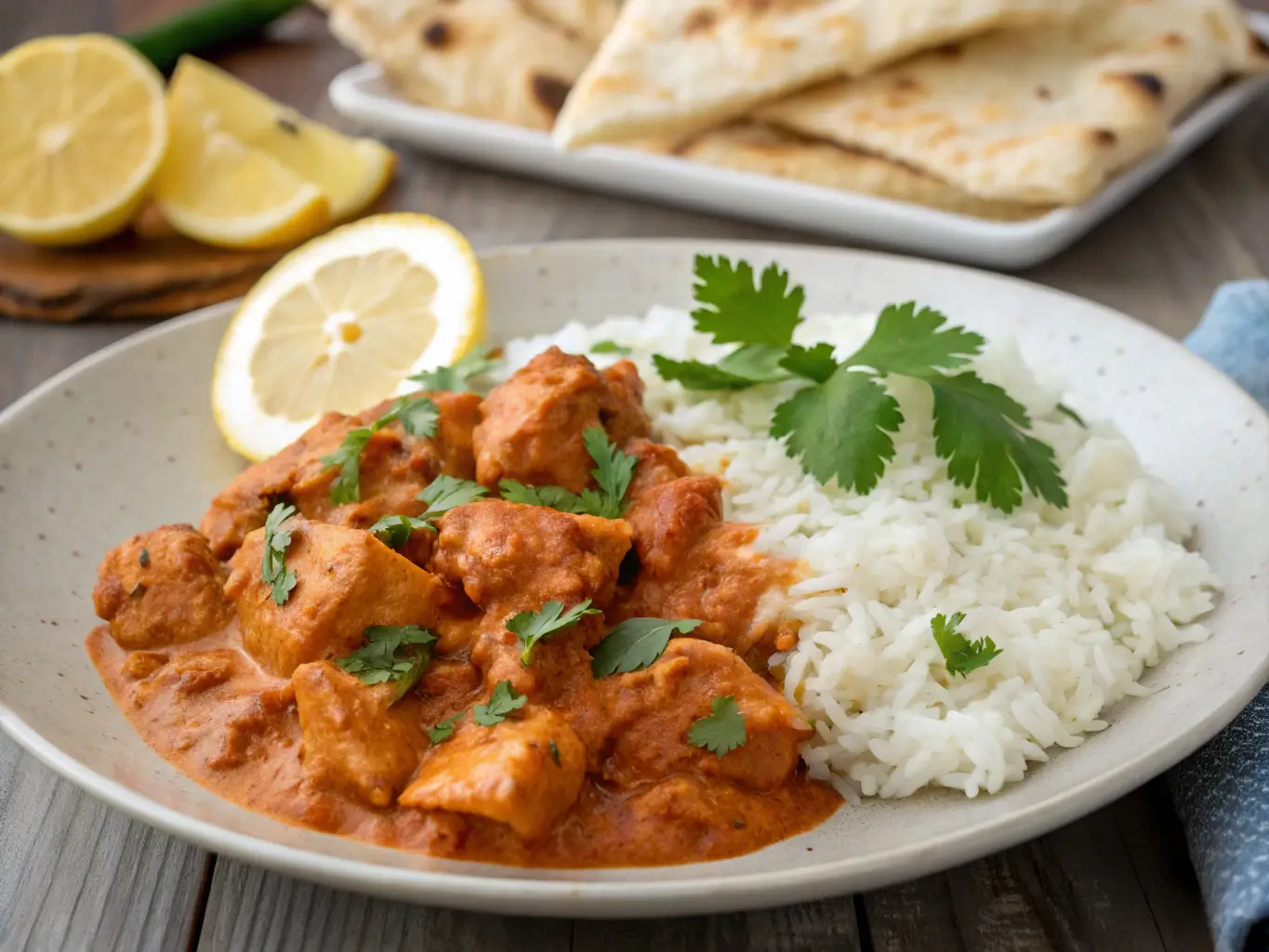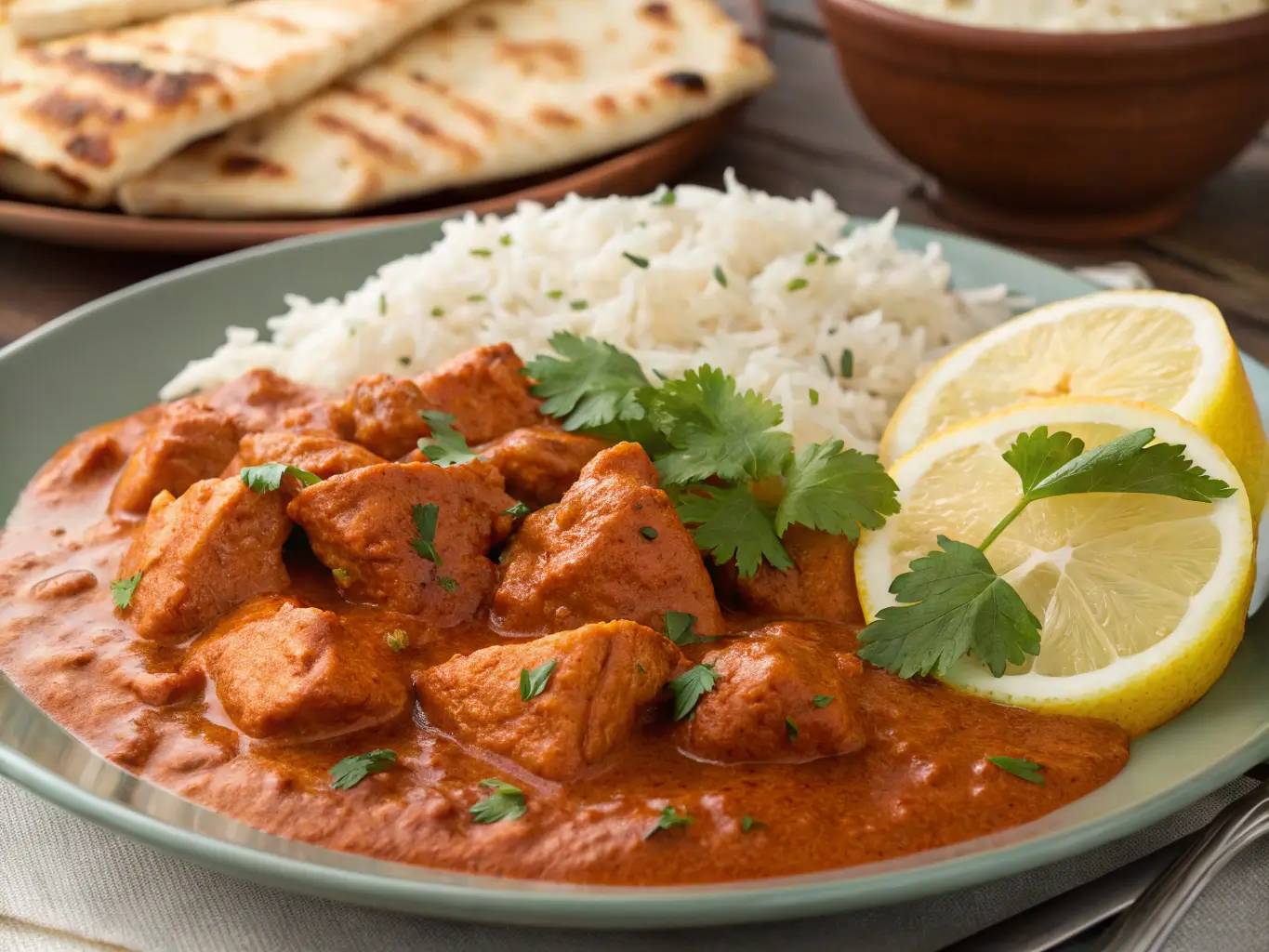Ultimate Chicken Tikka Masala: A Foolproof Guide to the Creamiest, Most Flavorful Curry
Few dishes are as universally beloved as Chicken Tikka Masala—a luscious, aromatic curry that perfectly balances smoky charred chicken with a velvety tomato-cream sauce. Whether you’re a busy home cook or an aspiring chef, this restaurant-quality recipe delivers tender, spice-infused chicken in a rich, complex gravy that’s sure to impress.
In this comprehensive guide, you’ll discover:
The science behind the perfect marinade (why yogurt works wonders)
How to layer spices for maximum depth of flavor
Pro tips for adjusting heat and creaminess to taste
Time-saving shortcuts without sacrificing authenticity
Expert troubleshooting for common mistakes
We’ll also explore the dish’s fascinating origins, uncover regional variations, and provide make-ahead strategies for effortless meals. Let’s embark on this flavorful journey!

The Rich History of Chicken Tikka Masala: A Global Culinary Icon
The origins of Chicken Tikka Masala are as richly spiced as the dish itself. While its exact birthplace is disputed, food historians agree it’s a brilliant example of cultural fusion cuisine.
The Scottish Connection
One popular theory credits a Glasgow chef in the 1970s who, when faced with a customer complaining about dry chicken tikka, improvised a sauce using tomato soup and spices. This quick fix allegedly birthed the now-iconic dish.
The Punjabi Roots
Others argue it evolved from Punjabi Butter Chicken (Murgh Makhani), created in Delhi’s Moti Mahal restaurant during the 1950s. The original used tandoori chicken pieces in a tomato-cream gravy—strikingly similar to today’s tikka masala.
Global Recognition
By 2001, British Foreign Secretary Robin Cook declared Chicken Tikka Masala “a true British national dish,” reflecting the UK’s multicultural identity. Today, it’s celebrated worldwide, with each region adding its own twist—from extra cream in the West to smokier versions in North India.
Why This Recipe Works: The Science Behind the Flavors
What makes this Chicken Tikka Masala truly exceptional? Let’s break down the culinary magic:
1. The Yogurt Marinade: Your Secret Weapon
- Yogurt’s acidity tenderizes chicken while keeping it juicy.
- Lactic acid breaks down proteins, resulting in melt-in-your-mouth texture.
- Fat content (especially in full-fat yogurt) helps spices adhere better.
2. Spice Layering: Building Complexity
Toasting whole spices (like cumin seeds) before grinding them unlocks volatile oils, creating deeper flavors. Adding ground spices at different stages—some in the marinade, some in the sauce—ensures balanced heat and aroma.
3. The Maillard Reaction: Flavor Through Char
High-heat cooking (grilling/broiling) creates those coveted dark spots on the chicken. This Maillard reaction produces hundreds of new flavor compounds, adding smoky depth to the final dish.
Ingredients & Equipment: Your Flavor Toolkit
For the Chicken Marinade:
- 1 cup (240g) full-fat yogurt (Greek or traditional Indian dahi)
- 2 tbsp lemon juice (freshly squeezed for best results)
- 1 tbsp freshly grated ginger (or ginger paste)
- 1 tbsp garam masala (the soul of the dish!)
- 1.5 lbs (700g) boneless, skinless chicken thighs (thighs stay juicier than breast)
- 1 tsp ground cumin (toasted and freshly ground if possible)
- 1 tsp turmeric (for color and earthy notes)
- 6 garlic cloves, minced (about 1 tbsp)
- 1 tsp Kashmiri red chili powder (milder than cayenne; substitute with paprika + pinch of cayenne)
- 1 tsp salt (adjust to taste)
For the Masala Sauce:
- 3 tbsp ghee or neutral oil (ghee adds authentic richness)
- 2 large onions, finely diced (about 2 cups; yellow or red work)
- 6 garlic cloves, minced
- 1 tbsp ginger paste
- 1 tsp ground coriander
- 2 tsp garam masala
- 1 tsp cumin powder
- 1 tsp turmeric
- 1–2 tsp Kashmiri chili powder (adjust for heat preference)
- 1 (28 oz/800g) can crushed tomatoes (San Marzano for best flavor)
- 1.5 cups (360ml) heavy cream (or coconut milk for dairy-free)
- 1 tbsp jaggery or brown sugar (balances tomato acidity)
- 1 tbsp kasuri methi (dried fenugreek leaves) – the secret ingredient!
- Salt to taste
Essential Equipment:
- Large mixing bowl (for marinating)
- Cast-iron skillet or heavy-bottomed Dutch oven (even heat distribution)
- Blender or immersion blender (for silky-smooth sauce)
- Tongs (for flipping chicken)
- Mortar and pestle (for toasting and grinding whole spices)
Step-by-Step Cooking Guide
1. Marinate the Chicken (2+ Hours, Overnight Ideal)
- In a large bowl, whisk yogurt, lemon juice, garlic, ginger, and all dry spices.
- Add chicken, ensuring each piece is fully coated.
- Cover and refrigerate at least 2 hours (overnight maximizes flavor penetration).
Pro Tip: For extra-tender chicken, pierce thighs with a fork before marinating.
2. Cook the Chicken (2 Methods)
Grill/Broil Method (Authentic Char)
- Preheat grill or broiler to high heat (450°F/230°C).
- Thread chicken onto skewers (if using wooden, soak 30 mins first).
- Grill 5–6 minutes per side until slightly charred and internal temp reaches 165°F (74°C).
Stovetop Method (Quick & Easy)
- Heat 1 tbsp oil in a skillet over medium-high.
- Cook chicken 4–5 minutes per side until browned.
Rest chicken 5 minutes before slicing into bite-sized pieces.
3. Build the Masala Sauce (Layered Flavor Technique)
- Sauté Aromatics: Heat ghee/oil; cook onions 10–12 mins until deep golden.
- Toast Spices: Add garlic, ginger, and dry spices; cook 1 minute until fragrant.
- Tomato Base: Stir in crushed tomatoes and sugar; simmer 15 mins until thickened.
- Blend (Optional): For ultra-smooth sauce, blend with an immersion blender.
- Finish with Cream: Reduce heat to low; stir in cream and kasuri methi.
4. Combine & Simmer (Flavor Fusion)
- Add cooked chicken to sauce.
- Simmer 8–10 mins on low heat (avoid boiling to prevent curdling).
Expert Troubleshooting & Pro Tips
Avoiding Common Mistakes
🔥 Sauce too thin? Simmer uncovered longer or add 1 tbsp ground cashews.
🍅 Too acidic? Balance with ½ tsp more sugar or a pinch of baking soda.
🐔 Tough chicken? Don’t skip the marinade time; thighs > breasts for juiciness.
Next-Level Tricks
- Smoky Flavor: Add ½ tsp smoked paprika or use a charcoal grill.
- Extra Umami: Stir in 1 tsp tomato paste while cooking onions.
- Time-Saver: Use store-bought tandoori paste + yogurt for marinade.
Serving Suggestions & Pairings
Traditional Accompaniments
- Basmati rice (cooked with whole spices like cardamom)
- Buttery garlic naan or fluffy roti
- Cooling raita (yogurt with cucumber and mint)
Modern Twists
- Cauliflower rice (low-carb option)
- Quinoa (protein-packed alternative)
- Roasted vegetables (for a hearty bowl)
Garnish Like a Pro
- Fresh cilantro leaves
- Thinly sliced green chilies
- A swirl of cream or yogurt
- Lemon wedges for brightness

Storage & Meal-Prep Strategies
Refrigerating
- Store in an airtight container for up to 4 days.
- Reheat gently on the stove with a splash of water or cream.
Freezing
- Freeze sauce only (without cream) for 3 months.
- Thaw overnight; add fresh cream when reheating.
Make-Ahead Tips
- Marinate chicken up to 24 hours ahead.
- Prep sauce base (through blending) 2 days in advance.
- Double the recipe—leftovers taste even better!
Frequently Asked Questions
Q: Can I use chicken breast instead of thighs?
A: Yes, but reduce cooking time to 3–4 mins per side to prevent dryness.
Q: What’s the best yogurt substitute for marinating?
A: Dairy-free options like coconut yogurt work, but add 1 tsp cornstarch to help adhesion.
Q: How do I make it spicier?
A: Increase Kashmiri chili powder or add ½ tsp cayenne to the sauce.
Q: Can I make it in an Instant Pot?
A: Yes! Sauté onions/spices, then pressure cook with tomatoes for 10 mins. Finish with cream.
Final Thoughts: Your Ticket to Curry Mastery
Mastering Chicken Tikka Masala is a culinary milestone—one that rewards you with endless variations and crowd-pleasing meals. Whether you stick to tradition or experiment with bold twists, this dish epitomizes comfort food at its finest.
Now it’s your turn! Whip up this recipe, share your creations with #HomemadeTikkaMasala, and let us know: What’s your favorite curry secret? Happy cooking! 🍛✨
